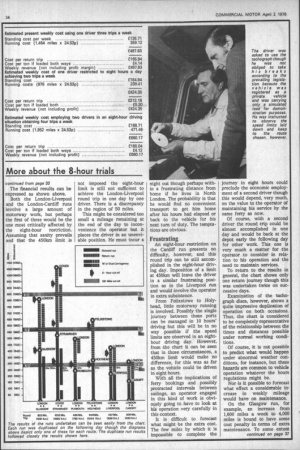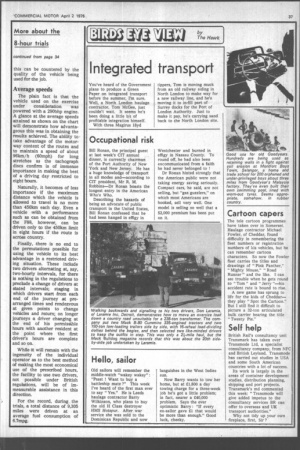More about the 8-hour trials
Page 35

Page 36

Page 39

If you've noticed an error in this article please click here to report it so we can fix it.
,Continuing last week's article about the likely effect on costs of the 8-hour driving day and the possibility of additional productivity helping to counter adverse trends THE EFFECT of the introduction of ECC driving hours regulations proposed in July could be partly countered by using two drivers on particular routes. This became clear from the article published last week, based on trials organised by Ailsa Trucks Ltd with CM's co-operation. This week we continue to examine the remaining routes and discuss the financial implications on the rest of these.
It should be reasonable to expect this return journey to be done in three days with two nights out under the present regulations. Under the proposed EEC rules, however, it would take at least 3i days with one driver considering the eight-hour driving-time restriction. With a 450km restriction take at least with a single also, it would four full days driver.
From the chart, it can be seen that the 450km limit would be reached from Dover in about 6 hours 25 minutes; a waste of 1 hour 35 minutes of a driver's allowable driving time.
Here the cost of employing a second driver is more economically justifiable. Under these circumstances the vehicle can continue for 16 hours (disregarding the 450km limit for a moment) and the round trip should be possible in two days.
Save a day This constitutes, in effect, a saving of one day on each round trip for the extra cost of about £50 a week or, on the basis of two trips a week, £25 a trip plus the added extra subsistence for the second driver so that the total per trip might be £30.
This is possible, for the driver need take only eight hours' rest in 24 on two occasions per week when the vehicle is away from its home base. Of course, there is not much spare time allowed for unforeseen occurrences and the two drivers would have to maintain a very tight schedule.
With a 450km limit, the twoday round trip appears to be still just possible but the schedule becomes so tight as to be unduly onerous.
It should be noted here that the average speed achieved during this run was only 63km/h (39.06mph) in contrast to that shown on the Glasgow run of 78km/h (48.36mph). This was, of course, attributable to the reduction in motorway running.
The same reason accounted for the even lower speed average on the London to Plymouth round trip on which, incidentally, I accompanied the vehicle myself. Here the average was only 57km/h (35.24 mph) along the route which began at Waterloo and gained M4 via Nine Elms, Battersea Bridge, Warwick Road and the Brompton Road extension. After leaving M4 at Bristol, the route followed A38 through Exeter and Buckfastleigh to Plymouth turning round to return to London by the reverse route at the junction with A3081. Using this route under the present 10-hour driving limit, the round trip should occupy 11 days. With a restriction of eight hours it w,in take the best part of two. This would suggest a 33 per cent increase in standing costs for a one-driver trip.
Employing two drivers, how, ever, could see the vehicle back at the depot on the same day for 450km seems to be about as far as the driver would get in eight hours driving on this route and the second eight hours for the relief driver is more than adequate to return to the depot. It seems possible, then, to achieve an extra trip a week for the extra weekly standing cost, say £50 for the second driver's wages. The financial results can be expressed as shown above.
Both the London-Liverpool and the London-Cardiff runs involve a large amount of motorway work, but perhaps the first of these would be the one most critically affected by the eight-hour restriction. Assuming that sanity prevails and that the 450km limit is not imposed the eight-hour limit is still not sufficient to achieve the London-Liverpool round trip in one day by one driver. There is a discrepancy in the region of 50 miles.
This might be considered too small a mileage remaining at the end of the day to inconvenience the operator but it places the driver in an unenviable position. He must incur a night out though perhaps within a frustrating distance from home If he lives in North London. The probability is that he would find no convenient transport to get him home after his hours had elapsed or back to the vehicle for his next turn of duty. The temptations are obvious.
Frustrating
An eight-hour restriction on the Cardiff run presents no difficulty, however, and this round trip can he still accomplished in the eight-hour driving day. Imposition of a limit at 450km will leave the driver in a similar frustrating position as in the Liverpool run and would involve the operator in extra subsistence.
From Felixstowe to Holyhead, little motorway running is involved. Possibly the single journey between these ports can be managed in 10 hours' driving but this will be in no way possible if the speed limits are observed in an eighthour driving day. However, from the chart it can be seen that in those circumstances, a 450km limit would make no difference, for this was as far as the vehicle could be driven in eight hours.
With all the implications of ferry bookings and possibly protracted intervals between sailings, an operator engaged in this kind of work is obviously going to have to look at his operation very carefully in this context.
It is difficult to forecast what might be the extra cost. The few mile3 by which it is impossible to complete the journey in eight hours could preclude the economic employment of a second driver though this would depend, very much, on the value to the operator of maintaining his service by the same ferry as now.
Of course, with a second driver the round trip could be almost accomplished in one day and would be back at the depot early the following day for other work. This one is very much a matter for the operator to consider in relation to his operation and the need to maintain services.
To return to the results in general, the chart Shows only one return journey though this was undertaken twice on successive days.
Examination of the tachograph discs, however, shows a quite impressive 'duplication of operation on bath occasions. Thus, the chart is considered to be completely representative of the relationship between the times and distances possible under normal working conditions.
Of course, it is not 'possible to predict what would happen under abnormal weather conditions, for instance, but these hazards are common to vehicle operation whatever the hours regulations might be.
Nor is it possible to forecast what effect a considerable increase in weekly mileage would have on maintenance.
On the Glasgow run, for example, an increase from 1,600 miles a week to 4,000 miles is bound to have some cost penalty in terms of extra maintenance. To some extent this can be countered by the quality of the vehicle being used for the job.
Average speeds
The plain fact is that the vehicle used on the exercise under consideration was powered with a 290bhp engine. A glance at the average speeds attained as shown on the chart will demonstrate how advantageous this was in obtaining the results achieved. The ability to take advantage of the motorway content of the routes and to maintain a speed of about 96km/h (60mph) for long stretches as the tachograph discs confirm is of immense importance in making the best of a driving day restricted to eight hours.
Naturally, it becomes of less importance if the maximum distance which the vehicle is allowed to travel is no more than 450km each day. Even a vehicle with a performance such as can be obtained from the F88, however, can be driven only to the 450km limit in eight hours if the route is across country.
Finally, there is no end to the permutations possible for using the vehicle to its best advantage in a restricted driving situation. These include two drivers alternating at, say, two-hourly intervals, for there is nothing in the regulations to preclude a change of drivers at stated intervals; staging in Which drivers start from each end of the journey at prearranged times and rendezvous at given points to change vehicles and return; on longer journeys a driver changing at the end of his permissible hours with another resident at the point where the first driver's hours are complete and so on.
While it will remain with the ingenuity of the individual operator as to the best method of making the most economical use of the prescribed hours, the facility to use two drivers, not possible under British regulations, will be of immeasurable assistance in this direction.
For the record, during the trials, a total distance of 9,305 miles were driven at an average fuel consumption of 6.7mpg.




























































































